CSIRO has opened a $90 million purpose-built research facility to store, digitise and protect the more than 13 million biological specimens that make up Australia’s national research collection.
Named Diversity, the National Research Collections Australia facility brings together the Australian National Wildlife Collection and the Australian National Insect Collection — representing 150 years of biological record — under one roof.
Funded through the government’s National Collaborative Research Infrastructure Strategy, the facility houses robust, temperature-controlled vaults that are resistant to bushfire and pests, alongside new genomics laboratories and digitisation spaces.

CSIRO chief executive Doug Hilton described the building at the CSIRO’s Canberra Black Mountain precinct as “central” to Australia’s future science capability, likening it to “a gallery or a museum that holds our national heritage”.
“It’s a library of our diversity. Being able to preserve that so future scientists can ask questions that are important in 10, 20, 100 years’ time is crucial,” Professor Hilton said at the launch on Thursday.
“It’s also important for us to tackle the questions that are burning right now – how do we preserve our biodiversity against climate change, land use changes, and invasive species?”
Supported by teams of expert taxonomists, imaging specialists and curators, the collection includes everything from native mammals, birds, fish and insects to preserved plant material and marine specimens.
CSIRO says the new facility allows specimens to be stored in a highly secure and environmentally stable environment, while also enabling automation and high-volume digitisation — capabilities that Professor Hilton said are “the envy of the world.”
“There are peer facilities like the Smithsonian in Washington DC or the British Museum of Natural History in London. But this one is right at the cutting edge and allows Australian scientists to do brilliant research,” he said.
The new building opens amid ongoing review of CSIRO’s research portfolio and staffing, with Professor Hilton confirming that some programs may be phased out to make way for new science priorities. He emphasised the need for the national science agency to continually adapt to emerging challenges.
“The questions we’re asking in 2025 are very different to those we asked in 1975. We have to make choices about what research delivers the biggest impact for Australia’s future,” he said, adding that redeployment would be prioritised where programs are wound down.
The collections have been used to track the impact of invasive species, study the evolution of Australia’s flora and fauna, and guide biosecurity and conservation policy.
CSIRO says the new facility will not only safeguard these resources but also open up new opportunities for international collaboration and advanced research into Australia’s biodiversity heritage.
CSIRO’s director for National Collections and Marine Infrastructure Toni Moate said the building will accelerate research into everything from new pharmaceuticals derived from insect venoms to understanding how species adapt to climate change.
“This is the newest purpose-built collections facility in the world. It will allow our researchers to move into new areas of science while preserving delicate specimens for decades to come,” Ms Moate said.
The vaults contain the world’s largest collection of Australian insects and related invertebrates – more than 12 million specimens – and the most comprehensive collection of Australian and Papua New Guinean bird species in the southern hemisphere. They also house the world’s largest cryo-frozen tissue bank of Australian birds.
Construction of Diversity began in autumn 2022 and finished just over two years later. Relocating the 13 million specimens took about a year.
While the facility is not open to the public, it will be a destination for scientists and collaborators from around the globe.
Do you know more? Contact James Riley via Email.
